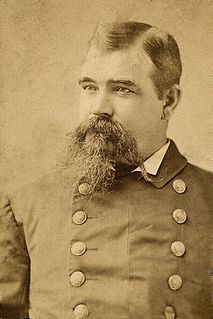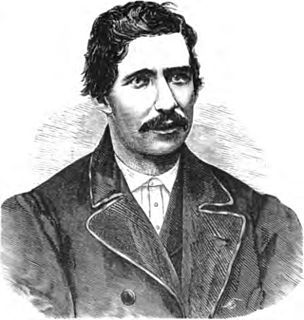
Police Academy 2: Their First Assignment is a 1985 American comedy film directed by Jerry Paris. It is the second installment in the Police Academy franchise and the sequel to Police Academy.

The Charlton Street Gang was a New York City street gang and river pirates during the mid-nineteenth century.

The Hook Gang was a street gang, and later river pirates, active in New York City in the 1860s and 1870s. The gang was prominent in the Fourth Ward and Corlear's Hook districts immediately after the American Civil War, until their breakup by the New York City Police Department in 1876.
Nicholas Saul was a prominent nineteenth-century criminal and one of the founding members of the Daybreak Boys, a New York City street gang. Saul led many of the gang’s early raids, many of which were before sunrise— earning the gang their nickname—on the Hudson River and East River waterfront. At its height during 1851 to 1853, the gang earned an estimated $200,000 under Saul's leadership.
The Tub of Blood Bunch was an early New York waterfront street gang of the late 1860s.

James Ford, born James N. Ford, also known as James N. Ford, Sr., the "N" possibly for Neal, was an American civic leader and business owner in western Kentucky and southern Illinois, from the late 1790s to mid-1830s. Despite his clean public image as a "Pillar of the Community", Ford was secretly a river pirate and the leader of a gang that was later known as the "Ford's Ferry Gang". His men were the river equivalent of highway robbers. They hijacked flatboats and Ford's "own river ferry" for tradable goods from local farms that were coming down the Ohio River.
Joseph Gayles, also known as Socco the Bracer, was one of the leaders of the Patsy Conroy Gang which plagued the dockyards of the New York City waterfront during the 1860s and 1870s. Described by New York police as one of the most vicious criminals on the docks, Gayles was suspected to be responsible for the murders of at least 20 men. According to one account, after finding little worth stealing in a raid on a brig, Gayles tied a sailor to a sea chest filled with sugar and heaved the chest overboard along with the sailor as he and three other members of the gang watched the man drown.
Joseph A. "Kid" Shanahan, also known as Thomas Lynch, was a New York City criminal, river pirate and member of the Patsy Conroy Gang. In May 1883, he was convicted with Thomas J. Reily, James McMann and James Moran of the attempted robbery of the sloop Victor while anchored at Flushing Bay. Upon boarding the vessel, they were forced to jump overboard at gunpoint by the ship's mate John Williams, although he rescued three of the would-be assailants from drowning while the gang's leader Moran was picked up by Captain Price of the nearby sloop Rebecca. Held in The Tombs in place of a $3,000 bail, Shanahan was tried for burglary and felonious assault, pleading guilty to all charges. He was sentenced to ten years imprisonment at Sing Sing Prison.
Suds Merrick was a New York river pirate and member of the Hook Gang during the 1870s. Merrick, along with Tommy Shay, James Coffee and Terry Le Strange, operated in the New York waterfront and involved in burglary and pickpocketing as well as raiding the nearby vessels anchored in the Hudson River. Merrick would co-lead the gang with Le Strange during the early 1870s until the arrest of Sam McCracken, Tommy Bonner, and Johnny Gallagher after they had looted the canal boat Thomas H. Brick and sent to Auburn State Prison in 1874. Following this incident, Merrick turned control of the Hookers to Bum Mahoney although he would remain with the gang in a limited capacity until his death in 1884.

Sadie Farrell was an alleged semi-folklorish American criminal, gang leader and river pirate known under the pseudonym Sadie the Goat. However, there exists doubt as to her historical existence.
Francis J. Banfield was an American soldier, law enforcement officer, police sergeant and founding member of the New York City Police Department "Steamboat Squad". Born in England, he emigrated to the United States as a child. He worked as a painter in his youth and later served in the Mexican-American War. He lived in California for a time before returning the New York to join the police force in June 1857.

George W. Gastlin born George Washington Gastlin was an American law enforcement officer and police captain, with the New York City Police Department, who founded the "Steamboat Squad" and served as its commander, during the 1870s and 80s.
Tom Flaherty, more commonly known under his pseudonym Old Flaherty, was an American criminal, sneak thief and river pirate in New York City during the mid-to late 19th century. He was the patriarch of a criminal family in New York's Seventh Ward which terrorized the New York waterfront in the post-American Civil War era. Flaherty was described as having "long white whiskers and a benevolent smile, but he was one of the most cruel thugs of the Seventh Ward".

Patrick Conway, commonly known by his alias Patsy or Patsy Conroy, was an American burglar and river pirate. He was the founder and leader of the Patsy Conroy Gang, a gang of river pirates active on the New York waterfront in the old Fourth Ward and Corlears' Hook districts during the post-American Civil War era.
Grafton was a 56-ton schooner sailing out of Sydney during the 1860s that was wrecked on 3 January 1864 in the north arm of Carnley Harbour, Auckland Island, one of the New Zealand Subantarctic Islands, nearly 480 kilometres (300 mi) south of the South Island. Her castaway crew waited a year for a ship to come to their rescue, which, it soon became apparent, would not come. Six months later, three men decided to set out in a dinghy and managed to cross a distance of 450 kilometres (280 mi) to Stewart Island, 30 kilometres (20 mi) south of New Zealand's South Island. They then funded a rescue mission to pick up their remaining companions. The crew spent a total of 18 months on the sub-Antarctic island and, despite their ordeal, all survived.

Michael "Pugsey" Hurley, also known by the aliases Pugsey Reilly or Hanley, was an English-born American burglar, river pirate and underworld figure in New York City during the mid-to late 19th century. An old time thief from the old Seventh Ward, he was also a well-known waterfront thug whose criminal career lasted over two decades. He especially gained notoriety as a member of the Patsy Conroy Gang and was a principal figure in many of their most infamous crimes.
Michael Mahoney, better known as Wreck Donovan or simply The Wreck, was a nineteenth-century American sneak thief, river pirate and underworld figure in New York City. He was a well-known criminal for hire on the New York waterfront during the post-American Civil War era and later became a member of Patsy Conroy Gang.

The Great Lakes Patrol was carried out by American naval forces, beginning in 1844, mainly to suppress criminal activity and to protect the maritime border with Canada. A small force of United States Navy, Coast Guard, and Revenue Service ships served in the Great Lakes throughout these operations. Through the decades, they were involved in several incidents with pirates and rebels.

A river pirate is a pirate who operates along a river. The term has been used to describe many different kinds of pirate groups who carry out riverine attacks in Asia, Africa, Europe, North America, and South America. They are usually prosecuted under national, not international law.

The Short Tails also known as the Short Tail Gang for their distinctive short tailed jacket coats were an 1880s-1890s Irish gang located in the Corlear's Hook section of the Lower East Side on Rivington street in the vicinity of Mangin and Goerck streets of Manhattan, in New York City. The Eastman Gang were also headquartered around Corlear's Hook and may have had its beginnings as a break away gang of the Short Tail Gang. The Short Tails along with rival gangs the Daybreak Boys, Patsy Conroy Gang, Swamp Angels, and Hook Gang worked the New York City waterfront plundering ships of their cargo on the East River. The Short Tail Gang was photographed in 1887, under a pier by noted photographer Jacob Riis, being one of the few 19th century New York gangs to allow its members to be photographed. In fear of being identified and arrested by the law, usually individual police mug shots were the only criminal pictures known to exist.













